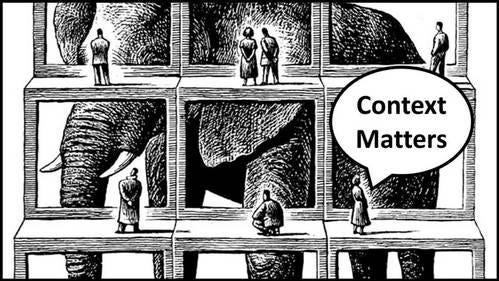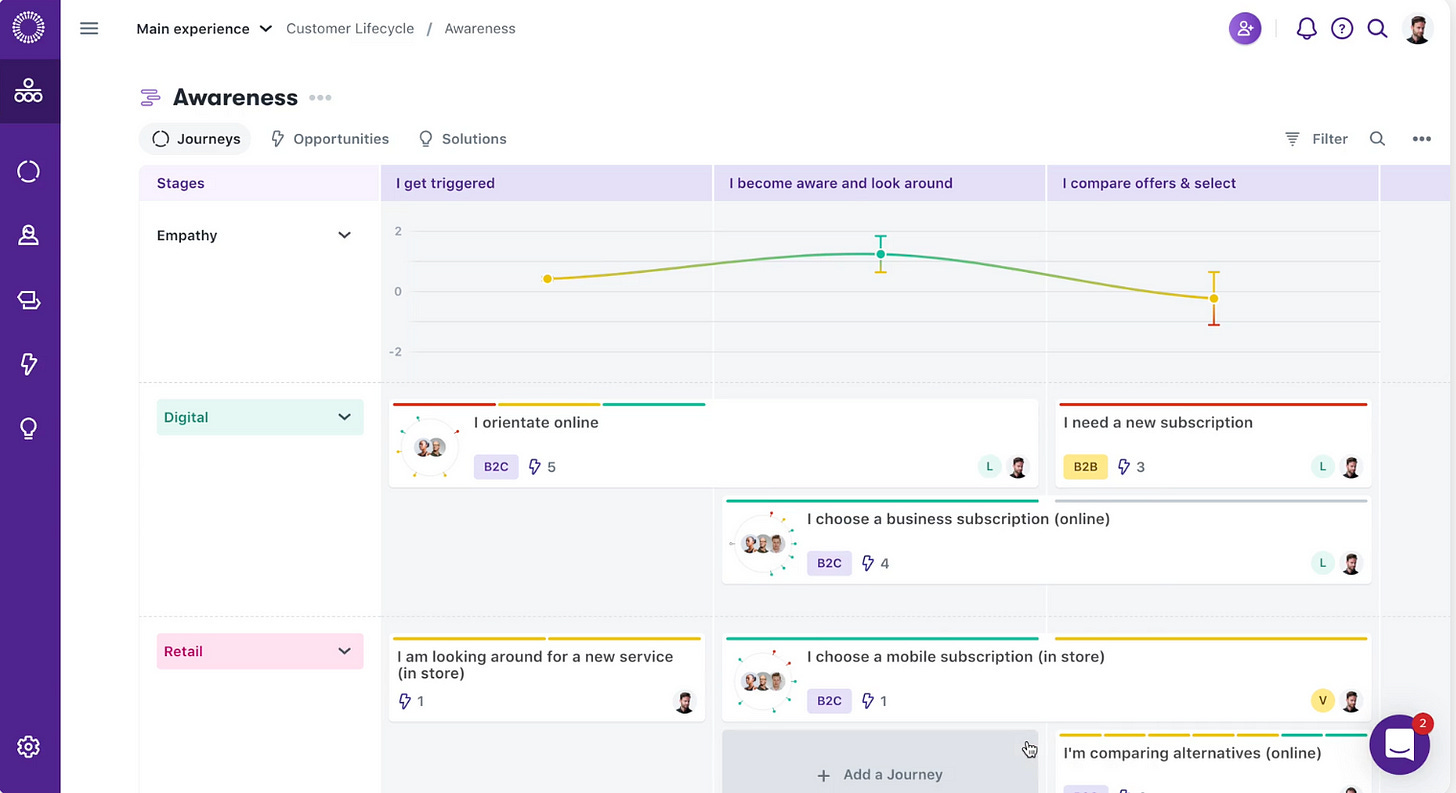Benefit #3 Journey management plays well alongside a range of existing frameworks
Which is great news! Introduce Journey Management to compliment and enhance your current ways of working. Here's how...
The pivotal importance of context
Over the years of consulting and advising businesses, I’ve learned the pivotal importance of context. No two businesses are the same and what works for one won’t necessarily work for another.
I kick off each client relationship understanding the lay of the land until I’m confident that the advice I provide is helpful.
I work mainly in digital consulting, so an important part of this is understanding the key frameworks that the business has adopted to get where they are today.
Some of my favourite frameworks
Working for some time in product management and customer experience I have some frameworks that I love! I go back to these time and again, because they get results.
I am a big believer in businesses sticking to what is working… and I am highly skeptical of the new shiny framework that requires businesses to ditch their current ways of working for something totally different.
Journey management enhances these frameworks
So I’m glad to share that Journey Management works well with all my favourite frameworks!
If you are using any of these frameworks currently, you can embed journey management without having to replace your current ways of working.
Furthermore, the additional customer insight that journey management creates actually supports and improves each of these frameworks!
Here’s a short paragraph on how each of these frameworks aligns to Journey Management.
(Note: I have specifically discussed some of these frameworks in the context of Theydo which is my Journey Management tool of choice.)
Journey mapping
I use Theydo for Journey Mapping.
The app is built specifically to support journey mapping and works very well! The interface is quick and easy interface to create personas, add in journeys and add contextual information like pictures, insights, pain points and opportunities.
We’ve seen in articles #1 and #2 how a single source of truth and a levelled journey framework add huge value compared to customer mapping. Article #4 explains how journey management creates a unified language which is an essential ingredient for any successful transformation.
Overall, journey mapping is greatly enhanced using Theydo.
(It is worth pointing out here that there are other good journey mapping options such as Smaply, Milkymap and Uxpressia. I use Theydo for the added value Journey Management and CX transformation features, but for journey mapping there a variety of good options available.)
Agile and continuous Delivery
Agile is it's own thing.
The agile process doesn't belong in Journey Management tools, and I don't think anyone would suggest otherwise. The scrum teams will have their own tooling and documentation (E.g. Jira, Confluence, Monday, Trello, Aha, Product board, Github and plethora of other options)
Having said this, there are some opportunities for overlaying some top level scrum info into journey maps that provide useful insights.
Solutions in TheyDo form a customer facing innovation backlog
Solutions that are shown in TheyDo are customer facing features, and many of these will require development work. These solutions will be the scrum activities that lead to a new features in the customer experience.
A list of these solutions is basically a roadmap for customer facing changes.
For each solution, adding the expected go-live date orders the roadmap.
Tracking the projected Vs the actual go live date indicates the accuracy of delivery estimates for customer facing work.
For each solutions, adding an estimated impact on key metrics links scrum work to business impact.
Finally, an interesting metric could be the dev effort spent on solutions in TheyDo Vs effort on other dev work. There will always be a list of dev work that doesn't impact the customer: SRE, architectural work, introducing new technologies and tech debt are important activities that would not show up as solutions in TheyDo. The ratio of effort on items with Vs without customer impact would be an interesting metric to track and discuss.
Continuous Discovery
I'm a massive fan of Teresa Torres's continuous discovery framework and Opportunity Solution Tree maps (OSTs).
One reason I’m a big fan of Theydo is I can apply an approach very similar to Opportunity Solution Tree mapping.
Here’s how…
There is a large overlap between the foundational building blocks in Theydo Vs Opportunity Solution Trees:
TheyDo: Goals, Insights, Opportunities, Solutions
Continuous Discovery OSTs: Metrics, Opportunities, Solutions, Experiments
So there's a big cross over here.
1: Top level business metrics
Early on in an engagement I like to ask leadership: 'What are your North Star metrics you aim to move the dial on over the coming year? What will indicate business success?'
This is often a business growth metric like:
Increase customer numbers, Increase monthly recurring revenue, Increase average spend per customer, increase clients.
Theydo provides goals. These work at the business level so I can track these in the app and attach opportunities and solutions to these.
2: Macro journey overview information
We looked at the levelled journey framework that is a core component of Journey Management in Article #2:
For each Macro journey there is some key overview information I find super useful to define each Macro journey:
The Key Metrics at Macro Journey level are super useful for recreating an Opportunity Solution tree type approach. This metric is at the journey level, so innovations in this journey should impact this metric. This metric should also be leading metric that links to one or more goals, so when the metric improves this indicates the business is succeeding, reflected in an improved business level metric.
3: Prioritise opportunities linked to Key Macro Journey Metrics)
A workshop with the team to understand our customer problems and opportunities based on customer insight.
The team bring to the table the customer problems, opportunities and potential solutions that they've seen from their customer interactions and describe this to the team.
The team score each opportunity based on:
How likely will this opportunity drive improvements in our Macro Journey Metrics?
Do we think there are viable solutions to realise this opportunity?
Do we think we can quickly test and validate the value of potential solutions?
Based on this, we can select one or two opportunities to focus on and design out solutions and experiments to solve this.
4: Leadership playback: Linking innovations to business metrics
Playing back to leadership this gives us some high impact information:
A top level business metric, that is a leadership focus
A Macro Journey key metric - a leading metric that links to top level business goals.
A prioritised list of opportunities, based on which we think will drive the Macro Journey Metric
A list of solutions - innovations to solve the opportunity
This gives a complete story of how our innovation work links to customer and business success. It draws a red line from the metrics leadership want to move, the customer problems we are solving, the solutions we are trialling and the impact this is having.
This information is super valuable for getting leadership buy in.
Design Sprints
Design sprints are the phenomenon developed by Google Ventures and popularised in the Sprint Book. It is a time-limited process lasting typically four or five days that helps teams solve complex problems and develop innovative solutions.
It involves understanding the problem, generating a variety of ideas, selecting the most promising one, creating a prototype, and testing it with real users or stakeholders. This structured framework promotes collaboration, creativity, and rapid iteration, allowing teams to efficiently validate ideas and make informed decisions in a short timeframe.
How Design Sprints work with Journey Management
Design Sprints are conducted and documented in a separate space, probably in Miro, Mural, Figjam or on a wall if run in person.
There are some really useful opportunities for overlaying some top level design sprint info into the Journey Framework. Here are some examples:
Design sprints aim to quickly find answers to large challenges. The outcome of a design sprint will likely be:
The rework of several existing journeys, or
The creation of a new set of journeys.
At the problem framing stage of the design sprint, when figuring out the context, scope and goals for the design sprint, Journey maps provide useful for context and a starting point for shared understanding.
By analysing current journeys, we can see:
Which journeys may be impacted directly and indirectly by the design sprint
Which teams should be included directly in the design sprint
Which teams should be included in comms
After the design sprint, the outcomes can be distilled down into future journey maps, the design sprint outputs can be linked to this and the impact of these discussed with the teams involved.
Journey Management provides useful context that supports good communication in the run up to the design sprint and after it finishes.
Jobs to be done
Jobs theory is a great way to gather deep customer insight and distill this into the 'real' job that the customer is trying to complete in their life.
Jobs to be done is a mindset about customer progress and framing the journeys that we build for customers in their actual goals in life.
There is plenty of opportunity in Journey Management to frame journeys in the context of the real customer problems. To do this requires high quality, in depth customer insight and then overlaying these insights onto the journey map descriptions.
One place I advocate for this strongly is in the Macro Journey Overview Information. For each Macro Journey I find it super helpful to document the job to be done… this actual job that is completed at stage.
In addition, documenting the key drivers is super useful framing. When designing a service we always focus on the functional motivation, the actual output. But the emotional and social drivers are often a much stronger incentive to action.
Jobs to be done is a great technique for establishing a unified customer centric language which is the topic in benefit #4.
In summary
Over the last 3 articles I have run through some foundational benefits of Journey Management:
A single source of truth, that everyone in the business can access
A levelled journey framework, that helps us see our customer’s experience at different levels
Plays well with existing frameworks, so businesses can adapt and enhance how they currently work
And I have explained at how this helps companies by centralising and democratising CX information.
The next 4 articles move beyond the foundations to Journey Management. I look at how you can build on these foundations to increase your CX maturity to support better business decisions and drive growth.
More articles and videos on Journey Management
Understand Journey Management in 8 minutes
A short video that explains the fundamentals of Journey Management and how this is revolutionising innovation. (If you’re new to Journey Management, start here.)
The benefits of Journey Management (Series)
Learn more about the business benefits of Journey Management in this series. (Useful for digital leaders explaining Journey Management to their organisation.)
About me
My name is Simon Conway, A Journey Management Consultant: I help digital leaders succeed with Journey Management. I provide:
Education: For teams new to journey management
Pilot development: For CX and Product leaders making a case for Journey Management and win buy-in for
Scaling and transformation design: For Digital Leaders looking to embed journey management across your business
Coaching: 1:1 tailored support, helping digital leaders to succeed with Journey Management
Learn more and connect
View more articles on Journey Management
View my portfolio, to see how I help organisations to succeed with Journey Management













